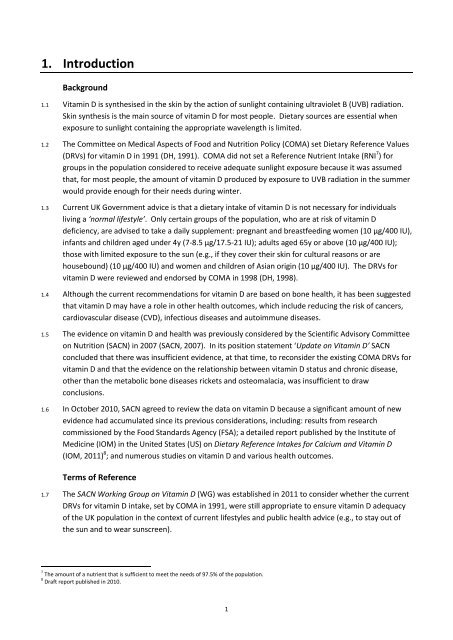Vitamin D and Health
SACN_Vitamin_D_and_Health_report
SACN_Vitamin_D_and_Health_report
Create successful ePaper yourself
Turn your PDF publications into a flip-book with our unique Google optimized e-Paper software.
1. Introduction<br />
Background<br />
1.1 <strong>Vitamin</strong> D is synthesised in the skin by the action of sunlight containing ultraviolet B (UVB) radiation.<br />
Skin synthesis is the main source of vitamin D for most people. Dietary sources are essential when<br />
exposure to sunlight containing the appropriate wavelength is limited.<br />
1.2 The Committee on Medical Aspects of Food <strong>and</strong> Nutrition Policy (COMA) set Dietary Reference Values<br />
(DRVs) for vitamin D in 1991 (DH, 1991). COMA did not set a Reference Nutrient Intake (RNI 7 ) for<br />
groups in the population considered to receive adequate sunlight exposure because it was assumed<br />
that, for most people, the amount of vitamin D produced by exposure to UVB radiation in the summer<br />
would provide enough for their needs during winter.<br />
1.3 Current UK Government advice is that a dietary intake of vitamin D is not necessary for individuals<br />
living a ‘normal lifestyle’. Only certain groups of the population, who are at risk of vitamin D<br />
deficiency, are advised to take a daily supplement: pregnant <strong>and</strong> breastfeeding women (10 µg/400 IU),<br />
infants <strong>and</strong> children aged under 4y (7-8.5 µg/17.5-21 IU); adults aged 65y or above (10 µg/400 IU);<br />
those with limited exposure to the sun (e.g., if they cover their skin for cultural reasons or are<br />
housebound) (10 µg/400 IU) <strong>and</strong> women <strong>and</strong> children of Asian origin (10 µg/400 IU). The DRVs for<br />
vitamin D were reviewed <strong>and</strong> endorsed by COMA in 1998 (DH, 1998).<br />
1.4 Although the current recommendations for vitamin D are based on bone health, it has been suggested<br />
that vitamin D may have a role in other health outcomes, which include reducing the risk of cancers,<br />
cardiovascular disease (CVD), infectious diseases <strong>and</strong> autoimmune diseases.<br />
1.5 The evidence on vitamin D <strong>and</strong> health was previously considered by the Scientific Advisory Committee<br />
on Nutrition (SACN) in 2007 (SACN, 2007). In its position statement ‘Update on <strong>Vitamin</strong> D’ SACN<br />
concluded that there was insufficient evidence, at that time, to reconsider the existing COMA DRVs for<br />
vitamin D <strong>and</strong> that the evidence on the relationship between vitamin D status <strong>and</strong> chronic disease,<br />
other than the metabolic bone diseases rickets <strong>and</strong> osteomalacia, was insufficient to draw<br />
conclusions.<br />
1.6 In October 2010, SACN agreed to review the data on vitamin D because a significant amount of new<br />
evidence had accumulated since its previous considerations, including: results from research<br />
commissioned by the Food St<strong>and</strong>ards Agency (FSA); a detailed report published by the Institute of<br />
Medicine (IOM) in the United States (US) on Dietary Reference Intakes for Calcium <strong>and</strong> <strong>Vitamin</strong> D<br />
(IOM, 2011) 8 ; <strong>and</strong> numerous studies on vitamin D <strong>and</strong> various health outcomes.<br />
Terms of Reference<br />
1.7 The SACN Working Group on <strong>Vitamin</strong> D (WG) was established in 2011 to consider whether the current<br />
DRVs for vitamin D intake, set by COMA in 1991, were still appropriate to ensure vitamin D adequacy<br />
of the UK population in the context of current lifestyles <strong>and</strong> public health advice (e.g., to stay out of<br />
the sun <strong>and</strong> to wear sunscreen).<br />
7 The amount of a nutrient that is sufficient to meet the needs of 97.5% of the population.<br />
8 Draft report published in 2010.<br />
1


